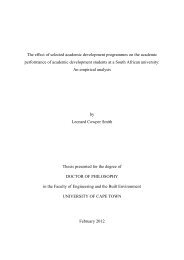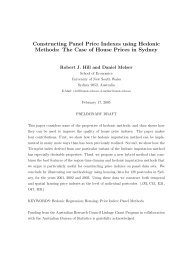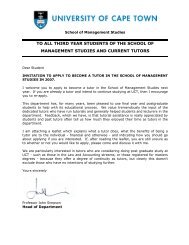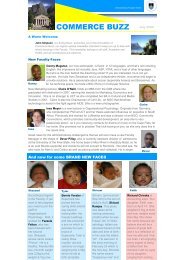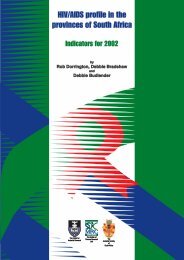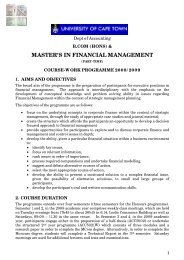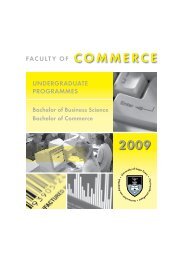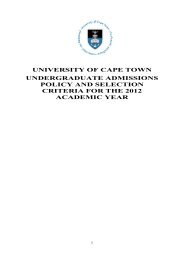Competition and Regulation in the Telecommunications Industry in ...
Competition and Regulation in the Telecommunications Industry in ...
Competition and Regulation in the Telecommunications Industry in ...
Create successful ePaper yourself
Turn your PDF publications into a flip-book with our unique Google optimized e-Paper software.
<strong>Competition</strong> <strong>and</strong> <strong>Regulation</strong> <strong>in</strong> <strong>Telecommunications</strong>relative density of subscribers. Wireless is cheaper at lower densities due to <strong>the</strong> lowfixed costs, while fixed l<strong>in</strong>e is cheaper at higher densities. The cross-over po<strong>in</strong>t isestimated to be <strong>in</strong> <strong>the</strong> range of 200-800 subscribers per km 2 from US <strong>and</strong> UK studies(Cave 1995). This makes mobile more expensive <strong>in</strong> urban <strong>and</strong> metropolitan areaswith high subscriber rates. However, <strong>in</strong> many develop<strong>in</strong>g countries with lowtelephony density of use, cellular is prov<strong>in</strong>g to be a good substitute for fixed l<strong>in</strong>e(South Africa may well be a case <strong>in</strong> po<strong>in</strong>t). Rapid technological developments <strong>in</strong>mobile communications could make it even more substitutable.Mobile telecommunications also <strong>in</strong>cludes satellite personal communications services.Satellite makes use of more powerful devices to transmit to one of a number of earthstations, which <strong>in</strong> turn l<strong>in</strong>k to each o<strong>the</strong>r via one or more satellites. The greaterdistances <strong>the</strong> receiv<strong>in</strong>g equipment must transmit over, means <strong>the</strong>y are larger <strong>and</strong>more expensive than cellular. However, <strong>the</strong> use of satellites enables <strong>the</strong> network tom<strong>in</strong>imise <strong>the</strong> number of earth-based transmission stations. This will not be discussedbecause a) <strong>the</strong> first global start-ups have all failed, <strong>and</strong> b) <strong>the</strong> cost is so much higherthan fixed l<strong>in</strong>e or mobile that it cannot be considered remotely <strong>in</strong> <strong>the</strong> same market.O<strong>the</strong>r wireless communications also <strong>in</strong>clude <strong>the</strong> broadcast<strong>in</strong>g group (radio, free-to-airTV <strong>and</strong> Pay TV) which are one-to-many operations without two-way capacity <strong>and</strong> socannot offer telecommunications.F<strong>in</strong>ally, one can <strong>in</strong>clude two-way radio <strong>and</strong> radio trunk<strong>in</strong>g. Two-way radio is oftentransmitted over very short distances <strong>and</strong> <strong>in</strong>cludes networks for emergency services<strong>and</strong> communication with<strong>in</strong> a def<strong>in</strong>ed corporate space. Often <strong>the</strong> distances are shortenough that no transmission stations are required, <strong>and</strong> <strong>the</strong> h<strong>and</strong>-held devices aresufficient. The longer distances are covered by radio trunk<strong>in</strong>g, which operate <strong>in</strong> afashion similar to cellular networks. Nei<strong>the</strong>r are suitable for public local accesstelecommunications <strong>and</strong> so will not be discussed fur<strong>the</strong>r.Long Distance (National <strong>and</strong> International)Local access networks connect to a long distance network through a po<strong>in</strong>t-ofpresence(PoP). The long-distance network is made up of <strong>the</strong>se PoP exchanges <strong>and</strong>a transmission network. Given that <strong>the</strong>se networks draw on a large pool of localaccess subscribers, <strong>the</strong>y are able to get greater density of use <strong>in</strong> <strong>the</strong>ir transmissionnetworks. As a result, most long distance networks use fibre optic when us<strong>in</strong>g a fixedl<strong>in</strong>e solution. Alternative transmission mechanisms <strong>in</strong>clude satellite <strong>and</strong> microwave(national only). Despite <strong>the</strong> choice of technologies available, a s<strong>in</strong>gle market isdef<strong>in</strong>ed as one for national long-distance <strong>and</strong> for <strong>in</strong>ternational long distance. Inaddition, as most of <strong>the</strong>se networks have sufficient network speed for broadcastquality, <strong>the</strong>re is no real need to differentiate at <strong>the</strong> <strong>in</strong>frastructure stage between voice,data <strong>and</strong> video.As with local access, <strong>the</strong>re are economies of scope <strong>in</strong> roll<strong>in</strong>g out fibre optic longdistancenetworks. A substantial proportion of <strong>the</strong> costs are <strong>in</strong> pay<strong>in</strong>g royalties tol<strong>and</strong>owners to pass <strong>the</strong> transmission cable through <strong>and</strong> putt<strong>in</strong>g <strong>in</strong> place <strong>in</strong>frastructureto carry <strong>the</strong> transmission medium (Cave 1995). If a new entrant already has anational <strong>in</strong>frastructure (e.g. railways, electricity grid), <strong>the</strong>n some of <strong>the</strong>se costs will bespared allow<strong>in</strong>g a faster <strong>and</strong> cheaper rollout.8




